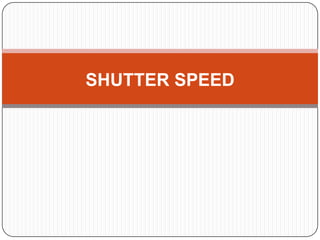
Shutter speed
- 2. In photography, a shutter is a device that allows light to pass for a determined period of time, for the purpose of exposing photographic film or a light-sensitive electronic sensor to light to capture a permanent image of a scene. The shutter is the part of the camera that controls the amount of time the imaging sensor is exposed to the light coming from the lens. It is normally closed and only opens momentarily when the shutter button is pressed. The time it takes for the shutter to stay open is referred to as the Shutter Speed and is measured in seconds or fractions thereof.
- 3. Types of Shutter There are different types of shutter but the common ones that are still being used today are the diaphragm shutter (leaf shutter) and the focal plane shutter. Focal Plane Shutter Diaphragm Shutter
- 4. Diaphragm Shutter A leaf shutter is a type of camera shutter consisting of a mechanism with one or more pivoting metal leaves which normally does not allow light through the lens onto the film, but which when triggered opens the shutter by moving the leaves to uncover the lens for the required time to make an exposure, then shuts. A diaphragm shutter is a type of leaf shutter consisting of a number of thin blades which briefly uncover the camera aperture to make the exposure. The blades slide over each other in a way which creates a circular aperture which enlarges as quickly as possible to uncover the whole lens, stays open for the required time, then closes in the same way. The larger the number of blades, the more accurately circular is the aperture. An odd number of blades is usually used: 3, 5, or more.
- 5. Focal Plane Shutter A focal plane shutter is so named because it sits directly in front of the focal plane (i.e., the film) of the camera. This is an advantage for interchangeable-lens cameras, because lenses do not need to have shutters built into them, and they can be removed and replaced while the shutter blocks light from the film. The most common type of focal plane shutter is the two-curtain type. It uses two fabric curtains travelling in the same direction across the focal plane. The first curtain opens across the focal plane, and after the appropriate delay, the second curtain closes behind it.
- 6. In most focal-plane shutters, the curtains travel at the same speed regardless of the speed setting: the shutter speed, the amount of time the film is exposed, is determined by the delay between the time the first curtain opens and the time the second curtain closes. Cocking the shutter moves the curtains back to their starting position. Because of the relative simplicity of this mechanism, it's easy to build shutters which can work accurately at very high shutter speeds, up to 1/2000 second. Modern focal plane shutters may operate either horizontally, as in the original Leica design, or vertically, as in the original Contax design. They may be made of fabric or of light metal sheets.
- 7. Shutter lag: Shutter lag is the time between pressing the shutter release and the camera responding by taking the picture. While this delay was insignificant on most film cameras and some digital cameras, it may be a problem when trying to capture subjects which are moving quickly such as in sports or other action photography. Shutter cycle: A shutter cycle is the process of the shutter opening, closing, and resetting to where it is ready to open again. The life-expectancy of a mechanical shutter is often expressed as a number of shutter cycles.
- 8. Shutter Speed In still cameras, the term shutter speed represents the time that the shutter remains open when taking a photograph. Along with the aperture of the lens (also called f-number), it determines the amount of light that reaches the film or sensor. Shutter settings are typically numbers in this kind of sequence: 2000, 1000, 500, 250, 125 - you can see the pattern here: each is half of the previous. Then it goes 60, 30, 15, 8 - kind of half, or nearly half each time. 4, 2, 1 …
- 9. 8 (1/8 sec) 30 (1/30 sec) 60 (1/60 sec) 500 (1/500 sec)
- 10. The shutter is a mechanical shade in the back center of the camera directly in front of the frame of film you are shooting. When the button on the camera to take a picture is pressed this shade opens for a fraction of a second. If the shutter is open for too little time the photograph will be too dark. If the shutter is open for too long the photograph will be too light. Many cameras allow the photographer to choose a shutter speed. The advantage of this type of camera is that by varying the shutter speed the photographer can control how motion will appear in the finished photograph.
- 11. 1/8000 will stop any motion 1/4000 high enough speed to take pictures while walking 1/2000 will stop most motion 1/1000 will stop bicyclists and runners 1/500 will freeze a person jumping in the air 1/250 will stop some motion 1/125 to avoid camera shake Speeds that blur motion. Use a tripod for these speeds. 1/60 slight blurring of motion 1/30 very good speed to show a bit of blur when photographing dancers
- 12. 1/15 the blurring of motion becomes clearly evident 1/8 the blurring motion becomes more pronounced 1/4 the blurring of motion becomes extreme 1/2 high speed motion begins to become invisible 1 medium speed motion begins to become invisible 2 all motion begins to become invisible 4 more motion begins to become invisible 8 motion develops a fog like quality
